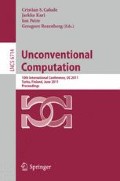Abstract
Abstract geometrical computation involves drawing colored line segments (traces of signals) according to rules: signals with similar color are parallel and when they intersect, they are replaced according to their colors. Time and space are continuous and accumulations can be devised to unlimitedly accelerate a computation and provide, in a finite duration, exact analog values as limits.
In the present paper, we show that starting with rational numbers for coordinates and speeds, the time of any accumulation is a c.e. (computably enumerable) real number and moreover, there is a signal machine and an initial configuration that accumulates at any c.e. time. Similarly, we show that the spatial positions of accumulations are exactly the d-c.e. (difference of computably enumerable) numbers. Moreover, there is a signal machine that can accumulate at any c.e. time or d-c.e. position.
http://www.univ-orleans.fr/lifo/Members/Jerome.Durand-Lose ,
Jerome.Durand-Lose@univ-orleans.fr
Access this chapter
Tax calculation will be finalised at checkout
Purchases are for personal use only
Preview
Unable to display preview. Download preview PDF.
References
Adamatzky, A. (ed.): Collision based computing. Springer, London (2002)
Adamatzky, A., Durand-Lose, J.: Collision computing. In: Corne, D. (ed.) Handbook of Natural Computing: Theory, Experiments, and Applications, Part II. Springer, Heidelberg (2010)
Ambos-Spies, K., Weihrauch, K., Zheng, X.: Weakly computable real numbers. J. Complexity 16(4), 676–690 (2000), doi:10.1006/jcom.2000.0561
Andréka, H., Németi, I., Németi, P.: General relativistic hypercomputing and foundation of mathematics. Nat. Comput. 8(3), 499–516 (2009)
Blum, L., Shub, M., Smale, S.: On a theory of computation and complexity over the real numbers: NP-completeness, recursive functions and universal machines. Bull. Amer. Math. Soc. 21(1), 1–46 (1989)
Duchier, D., Durand-Lose, J., Senot, M.: Fractal parallelism: Solving SAT in bounded space and time. In: Cheong, O., Chwa, K.-Y., Park, K. (eds.) ISAAC 2010. LNCS, vol. 6506, pp. 279–290. Springer, Heidelberg (2010), doi:10.1007/978-3-642-17517-6_26
Durand-Lose, J.: Abstract geometrical computation 1: Embedding black hole computations with rational numbers. Fund. Inf. 74(4), 491–510 (2006a)
Durand-Lose, J.: Forecasting black holes in abstract geometrical computation is highly unpredictable. In: Cai, J.-Y., Cooper, S.B., Li, A. (eds.) TAMC 2006. LNCS, vol. 3959, pp. 644–653. Springer, Heidelberg (2006b), doi:10.1007/11750321_61
Durand-Lose, J.: Abstract geometrical computation and the linear blum, shub and smale model. In: Cooper, S.B., Löwe, B., Sorbi, A. (eds.) CiE 2007. LNCS, vol. 4497, pp. 238–247. Springer, Heidelberg (2007), doi:10.1007/978-3-540-73001-9_25
Durand-Lose, J.: Abstract geometrical computation with accumulations: Beyond the Blum, Shub and Smale model. In: Beckmann, A., Dimitracopoulos, C., Löwe, B. (eds.) Logic and Theory of Algorithms, 4th Conf. Computability in Europe (CiE 2008) (abstracts and extended abstracts of unpublished papers), pp. 107–116. University of Athens, Athens (2008a)
Durand-Lose, J.: The signal point of view: from cellular automata to signal machines. In: Durand, B. (ed.) Journées Automates Cellulaires (JAC 2008), pp. 238–249 (2008b)
Durand-Lose, J.: Abstract geometrical computation 3: Black holes for classical and analog computing. Nat. Comput. 8(3), 455–472 (2009a), doi:10.1007/s11047-009-9117-0
Durand-Lose, J.: Abstract geometrical computation and computable analysis. In: Costa, J.F., Dershowitz, N. (eds.) UC 2009. LNCS, vol. 5715, pp. 158–167. Springer, Heidelberg (2009b), doi:10.1007/978-3-642-03745-0_20
Durand-Lose, J.: The coordinates of isolated accumulations [includes] computable real numbers. In: Ferreira, F., Guerra, H., Mayordomo, E., Rasga, J. (eds.) Programs, Proofs, Processes, 6th Int. Conf. Computability in Europe (CiE 2010) (abstracts and extended abstracts of unpublished papers), pp. 158–167. CMATI, U. Azores (2010a)
Durand-Lose, J.: Abstract geometrical computation 5: embedding computable analysis. Nat. Comput (2010b); Special issue on Unconv. Comp. 2009, doi:10.1007/s11047-010-9229-6
Etesi, G., Németi, I.: Non-Turing computations via Malament-Hogarth space-times. Int. J. Theor. Phys. 41(2), 341–370 (2002), http://www.gr-qc/0104023
Hagiya, M.: Discrete state transition systems on continuous space-time: A theoretical model for amorphous computing. In: Calude, C., Dinneen, M.J., Paun, G., Pérez-Jiménez, M.J., Rozenberg, G. (eds.) UC 2005. LNCS, vol. 3699, pp. 117–129. Springer, Heidelberg (2005)
Hogarth, M.L.: Deciding arithmetic using SAD computers. Brit. J. Philos. Sci. 55, 681–691 (2004)
Jacopini, G., Sontacchi, G.: Reversible parallel computation: an evolving space-model. Theoret. Comp. Sci. 73(1), 1–46 (1990)
Lloyd, S., Ng, Y.J.: Black hole computers. Scientific American 291(5), 31–39 (2004)
Takeuti, I.: Transition systems over continuous time-space. Electr. Notes Theor. Comput. Sci. 120, 173–186 (2005)
Weihrauch, K.: Introduction to computable analysis. Texts in Theoretical computer science. Springer, Berlin (2000)
Zheng, X.: A computability theory of real numbers. In: Beckmann, A., Berger, U., Löwe, B., Tucker, J.V. (eds.) CiE 2006. LNCS, vol. 3988, pp. 584–594. Springer, Heidelberg (2006) ISBN 3-540-35466-2, doi:10.1007/11780342_60
Author information
Authors and Affiliations
Editor information
Editors and Affiliations
Rights and permissions
Copyright information
© 2011 Springer-Verlag Berlin Heidelberg
About this paper
Cite this paper
Durand-Lose, J. (2011). Geometrical Accumulations and Computably Enumerable Real Numbers. In: Calude, C.S., Kari, J., Petre, I., Rozenberg, G. (eds) Unconventional Computation. UC 2011. Lecture Notes in Computer Science, vol 6714. Springer, Berlin, Heidelberg. https://doi.org/10.1007/978-3-642-21341-0_15
Download citation
DOI: https://doi.org/10.1007/978-3-642-21341-0_15
Publisher Name: Springer, Berlin, Heidelberg
Print ISBN: 978-3-642-21340-3
Online ISBN: 978-3-642-21341-0
eBook Packages: Computer ScienceComputer Science (R0)

